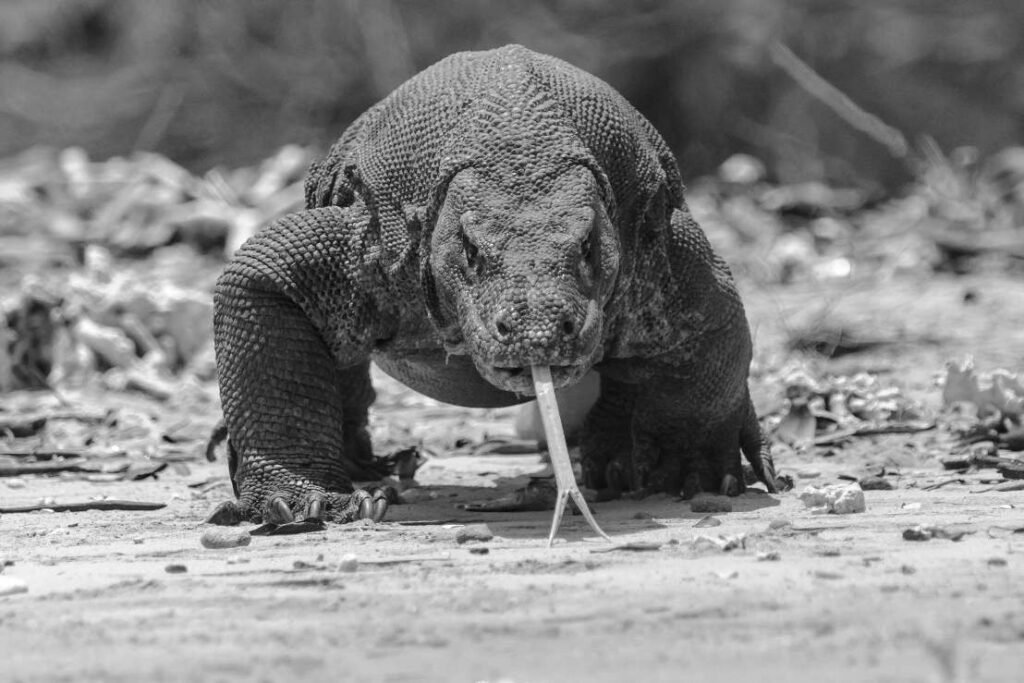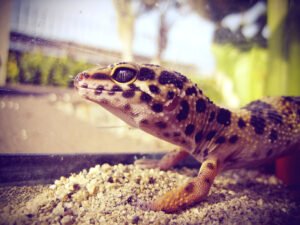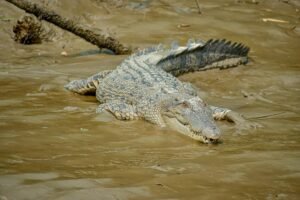Komodo Dragon: The Giant Lizard of Indonesia
Introduction
The Komodo Dragon is a fascinating and powerful reptile native to Indonesia. Known as the largest lizard on Earth, it captures the imagination of nature lovers and scientists alike. This reptile plays a vital role in its ecosystem and has many unique features that set it apart from other animals. In this article, we will explore everything about the Komodo Dragon—from its physical traits and hunting skills to its relationship with humans and conservation efforts.

Physical Description
The Komodo Dragon is impressive in size. Adult males can grow as long as 3 meters (10 feet) and weigh around 70 to 150 kilograms (154 to 330 pounds). Their bodies are robust, covered in tough, armored scales called osteoderms that protect them from injury. Their powerful legs end in sharp claws used for digging and catching prey.
A Komodo Dragon’s head is broad with a flat snout, and its mouth holds sharp, serrated teeth designed to tear flesh easily. Its tongue is long, yellow, and deeply forked, helping it sense its surroundings by detecting chemical cues in the air. The skin color ranges from dark brown to gray, enabling it to camouflage well in dry forest and savanna environments.
Habitat and Distribution
Komodo Dragons are found only on a few islands in Indonesia: Komodo, Rinca, Flores, Gili Dasami, and Gili Motang. These islands have hot, dry climates with tropical savanna forests, grasslands, and coastal areas where the dragons hunt and live.
They prefer lowland habitats but are known to climb trees when young and burrow into the ground or rocky caves for shelter. These environments provide plenty of food sources, including deer, wild boars, and smaller reptiles.
Diet and Hunting
The Komodo Dragon is a carnivorous predator and scavenger. Its diet mainly consists of large mammals such as Javan rusa deer, pigs, and water buffalo. They are also known to eat carrion, which means they consume dead animals they find.
Using stealth and power, Komodo Dragons stalk their prey quietly before pouncing. Their bite is venomous, injecting toxins that reduce blood clotting and cause shock in the prey over time. This venom, combined with their strong teeth and claws, allows them to take down animals much larger than themselves.
Behavior and Adaptations
Komodo Dragons are solitary creatures, spending most of their time alone except during mating or feeding gatherings. They have keen senses of smell and vision, detecting prey and threats from afar. Their forked tongue functions like a chemical sensor, flicking in and out to gather scents.
One important adaptation is their ability to regulate body temperature by moving between sunny and shaded areas. Despite being cold-blooded reptiles, this behavior helps maintain their activity levels.
Komodo Dragons also dig extensive burrows to shelter themselves from extreme weather and predators. Their large tails are used for balance during running and as a weapon if attacked.
Reproduction and Life Cycle
Breeding season varies by location but usually happens between May and August. Male Komodo Dragons compete for the chance to mate with females through physical combat, which may involve biting and wrestling.
Females lay between 15 to 30 eggs in large nests dug into the ground. The eggs incubate for about 7 to 8 months before hatching. Baby dragons are vulnerable and spend most of their early life in trees to avoid predators, including adult dragons.
Young Komodo Dragons grow quickly and reach maturity in about 8 to 9 years.
Relationship with Humans
Historically, Komodo Dragons have inspired both fear and admiration. Local people on Indonesian islands respect the dragons and have legends about their powers.
While attacks on humans are rare, they do happen, usually when dragons feel threatened or are hunting very near human settlements. Efforts to educate locals and tourists about safe behavior around Komodo Dragons have helped reduce such incidents.
Komodo Dragons attract tourists worldwide, boosting local economies. National parks protect these animals and promote responsible wildlife tourism.
Conservation Status
The Komodo Dragon is listed as Endangered on the IUCN Red List. The main threats include habitat loss due to human activities like farming and development, poaching of prey animals, and climate change affecting their island habitats.
Komodo National Park, a UNESCO World Heritage Site, plays a crucial role in protecting these creatures by regulating tourism, conducting research, and enforcing anti-poaching regulations.
Conservation programs also focus on raising awareness and supporting local communities to live sustainably alongside Komodo Dragons.
Fun and Interesting Facts
- Despite their large size, Komodo Dragons can run up to 20 km/h (12 mph).
- They have venomous saliva that helps weaken prey after a bite.
- Young dragons are arboreal (live in trees) to avoid being eaten by adults.
- Komodo Dragons can consume up to 80% of their body weight in one feeding.
- They use their strong tails to defend themselves or fight during mating battles.
Conclusion
The Komodo Dragon is a remarkable species that continues to fascinate people worldwide. Its unique adaptations, powerful hunting strategies, and important ecological role make it a key species to protect. By supporting conservation efforts and increasing awareness, we can help ensure the survival of this giant lizard for future generations.
Frequently Asked Questions (FAQs)
Q1: Where can Komodo Dragons be found?
A: They live mainly on five Indonesian islands: Komodo, Rinca, Flores, Gili Dasami, and Gili Motang.
Q2: How big do Komodo Dragons get?
A: Adult males can reach up to 3 meters (10 feet) in length and weigh around 150 kilograms (330 pounds).
Q3: Are Komodo Dragons venomous?
A: Yes, their bite injects venom that causes blood clotting problems and helps subdue prey.
Q4: What do Komodo Dragons eat?
A: They are carnivores feeding on deer, wild boars, smaller reptiles, and carrion.
Q5: Why are Komodo Dragons endangered?
A: Habitat loss, poaching, and climate change are the main threats to their survival.
Q6: Can Komodo Dragons attack humans?
A: Attacks are rare but possible, mostly when dragons feel threatened or hunt near human areas.
Q7: How do Komodo Dragons reproduce?
A: Females lay 15-30 eggs in nests, with young dragons living in trees during early life for protection.
Q8: What conservation efforts protect Komodo Dragons?
A: Komodo National Park protects their habitat and regulates tourism, while awareness programs involve local communities.
You can explore more about snakes on our website:
| Snake Name | Read More |
|---|---|
| Cobra Snake | Cobra Snake Information |
| Russell’s Viper | Russell’s Viper Snake Info |
| Common Krait | Common Krait Snake Info |
| Saw-scaled Viper | Saw-scaled Viper Info |


